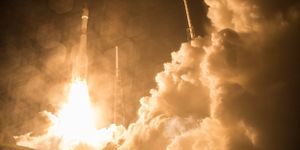Moon Express Is Taking Real Steps Toward Mining The Moon
Moon Express, a small company with only fifty employees, based in Mountain View California has just completed another step toward its goal of being the first private company to land on the Moon. The company's co-founder and chairman, Naveen Jain has even grander vision: with NASA's help, he plans to establish mining operations there.
In 2013, NASA launched its Lunar CATALYST (Lunar Cargo Transportation and Landing by Soft Touchdown) initiative. The goal is to partner with and encourage several US aerospace companies to design, create, and deploy robotic landers on the Moon. Apparently NASA is attempting to shift its role from running all of space exploration for the US, toward becoming a facilitator and a resource to private companies that will eventually be able to create and sustain space-based commercial ventures of their own. Jain's Moon-mining plan fits in perfectly with this goal.

Though NASA is partnering with two other companies through Lunar CATALYST, Astrobotic Technologies of Pittsburgh, Pennsylvania, and Masten Space Systems of Mojave, California, Moon Express has established itself as the clear leader of the pack. It is the only company so far to actually build and begin testing a prototype lander. Moon Express calls it the MX-1.
It is small, about the size of a coffee table, but it is designed to be a multi-fictional workhorse, capable of delivering a number of different scientific payloads to the Moon. Over the past few months, with the help of NASA, Moon Express has been conducting tethered tests of the prototype, for safely. But by the end of March they will advance to untethered tests.
One force driving Moon Express' progress is the very likely possibility that they will win Google's Lunar X Prize, a competition that will award 30 million dollars to the first company that can land a commercial spacecraft on the Moon, traverse 500 meters across its surface, and send high definition images and video back to earth.
"Winning the X prize would be a great thing," Jain said. "But building a great company is the ultimate goal with us." Though his words sound altruistic, there are very real riches on the Moon, including gold, platinum, cobalt, iron, palladium, tungsten and vast amounts of Helium-3, a gas that could be used in future fusion reactors to provide nuclear power without producing any radioactive waste. "We went to the Moon 50 years ago, yet today we have more computing power with our iPhones than the computers that sent men into space," Jain says. "That type of exponential technological growth is allowing things to happen that was never possible before."
Mining on the Moon? If Jain and his company maintain their current rate of progress, it may not be long before they transform this science-fiction trope into a profitable reality.








